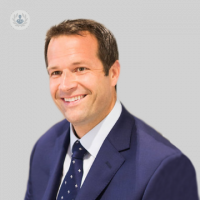How long does it take to recover from ACL surgery?
Written by:In this article below, esteemed orthopaedic surgeon, Mr Christopher Arthur Bailey, details how a typical ACL reconstruction is performed, outlines the main benefits of the surgery, and tells us what recovery time entails for patients.

What are the main benefits of ACL surgery?
When someone ruptures their ACL, their knee will often feel unstable and patients cannot engage in normal physical activity or sporting activity because their knee keeps giving way. So, what we aim to do through ACL surgery is reconstruct that ligament and provide the stability back to the knee.
The aim of the procedure is to allow patients to return to normal activities with a more stable knee, but also to protect the lining cartilage of the meniscal part of the knee and to prevent the risk of arthritis in the future.
Is ACL reconstruction safe?
It is a very safe procedure. It involves taking the hamstring tendons from the tibia attachment just below the knee joint to construct a new anterior cruciate ligament. We achieve this by drilling tunnels through the tibia and the femur and then pass the graft through these and hold them very tightly.
Can ACL surgery go wrong?
There is a small chance that the biology of the tissues doesn’t kick in as we would like it to or expect, and the graft sometimes doesn’t heal. There is a risk of re-rupturing the graft in the future but we generally get very good outcomes from ACL surgery.
How long does it take to recover from ACL surgery?
Most of these procedures are performed as day-case procedures, so patients are in and out in the same day. We allow patients to use crutches initially. People will normally be on crutches following ACL surgery for between two to four weeks.
In this time, we start physiotherapy and strengthening exercises to regain joint position sense. Having said that, it will take about six weeks before people can return to light activities at work, three months before people can do some heavier physical activities or light running on a treadmill, six months before people can start running outside, and around nine months before people can get back to physical or contact sport.
How should someone prepare for ACL surgery?
It’s really important to try to keep as active as possible before surgery as we want to try to best avoid the knee being stiff or the muscles to be wasted prior to surgery as the leg needs to be in the best possible condition.
Obviously, we want people to avoid any twisting of the knee and we often ask our physiotherapy colleagues to provide a pre-rehabilitation programme prior to surgery.
Consult with Mr Christopher Arthur Bailey by visiting his Top Doctors profile today.


